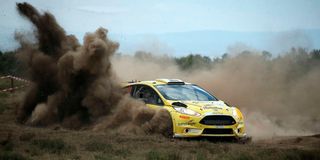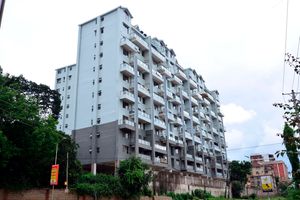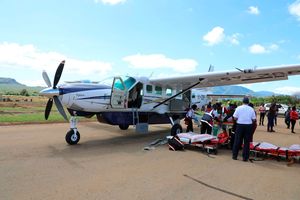
Carl Tundo navigated by Tim Jessop on a Skoda Fabia compete in Kedong stage on March 29, 2024 during the WRC Safari Rally.
This year’s edition of the FIA World Rally Championship (WRC) Safari Rally Kenya ended on Sunday. And just like all the editions since the WRC contest returned to Kenya in 2021, there was no Kenyan or East African winner, and none placed in the top 10.
There was a time when the story was different. As the contemporary WRC Safari Rally, Ugandan-Kenyan driver Shekhar Mehta won it five times, Kenyan driver Joginder Singh twice and his compatriot Ian Duncan once, in 1994, the last time any of our people smelt victory.
There is an elephant in the room, so let us get it out of the way. There is a colour thing here, because, even in the past, no “muntu” won it; previous victors were all East African Asians or white Africans, including in the time of the event’s predecessor, the East African Rally, which ran until 1974. In that iteration, Tanzanian-based Bert Shankland won it twice — in 1966 and 1967.
Watching the opening 4.5-kilometre special stage at Kasarani, in which many East African drivers posted times that were over one minute slower in that very short segment than the big boys, one would be tempted to conclude that today’s generation of drivers are lousy compared to the rallying ancestors like Joginder. That we have lost our racing mojo. Not exactly.
However, racial political economy offers one of the explanations for our absence on the podium. In East Africa, unlike football or boxing, historically, motor rallying (and cricket, if we may add) was a refuge of the urban Asian and white communities — the latter either as expatriates, settlers or colonials. They invested a lot of capital and channelled the talent of their communities into the sport.
Beginning with the mass expulsions of East African Asians from Uganda by military dictator Idi Amin in 1972, and the continued squeeze on them in Kenya, they set off an exodus and an emigration current that hasn’t ebbed.
History and geography lesson
There were more than 80,000 Asians in Uganda before the Amin expulsion. By the end of Amin’s rule in 1972, there were less than 1,200. The Asian population in Kenya declined from 179,000 in 1962 to 139,000 in 1969 and 78,000 in 1979. The Europeans, much fewer, also left in considerable numbers.
There were also opposite good forces other than expulsions and emigration. There was a greater “nativisation” of the Asian and white communities and integration with indigenous black communities, especially at the economic and social levels.
Soon, there were no longer majority Asian or white public schools, that privilege being left, for a brief while, to a few elite international schools. Hospitals, cricket and sports clubs became integrated. And the “local folks” moved into Westlands, Muthaiga and Karen.
Investing a lot of money and talent into motorsport became less compelling. The Asian and white Kenyans could now make more money selling cars to black Kenyans instead of racing them in rallies or setting up a supermarket.
There was also a major shift in the culture of, especially, the WRC event. In the past, the Safari Rally was a marathon, run for many days all over the country (and Uganda and Tanzania when it was the East African Rally, and before that the Coronation Safari Rally). The Safari Rally wasn’t just a motor race; it was a history and geography lesson the likes of which few would get in a classroom.
As a marathon and endurance race, it played to our strengths. The expansive area over which it was run is thought to have given some East African drivers an advantage as they had better local knowledge.
Technological leap
Then it all changed. The WRC became a series of sprints, run in restricted stretches (Naivasha), in short very fast stages, on closed roads — in Africa, offroad, on less used routes. Local knowledge, if it were ever important, became irrelevant.
But the killer has been technology. Fifty years ago, you could soup up your car for the WRC Safari Rally in a garage at the back of Kijabe Street and enter it into the race with a shot at a podium finish.
Previously, most of the work was concentrated on cars. If one watched the Safari Rally coverage or follows the WRC globally as some diehard East African petrolheads do, they will have seen that most of the people who work on rally teams sit far away in rooms filled with computers.
While there might be five mechanics working on a car, in their remote rooms there are over 30 bespectacled fellows peering at screens which are linked to their onboard computers. Materials technology is also next level. It all comes with a high price. The top-end WRC cars cost as much as $1 million (Sh132 million) apiece.
Ultimately, then, our good times at the WRC were rudely interrupted by three things. First, a technological leap that caught us out.
Secondly, we became more multicultural and cosmopolitan urban societies.
Thirdly, because we could no longer do what we are very good at — run it as a marathon.
Mr Onyango-Obbo is a journalist, writer and curator of the “Wall of Great Africans”. @cobbo3










